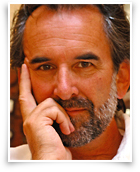
Richard Harvey
connecting psychotherapy and spiritual growth for human awakeningx
Listening: An Experiential Group Model
As a group facilitator I often use mini-group or dyad formats in larger group workshops. People who are new to this work, as well as people with a great deal of experience often bring a poor quality of attention to the passive-receptive aspect of group exercises. Lack of openness or indifferent listening may not only be a reflection of a group participant’s own inner turmoil, confusion or avoidance, but may also be due to an unpracticed, or unrecognized, ability to be passively available and receptive in a helping mode for another.
To some degree it seems the notion of “being present” (a common term in popular therapy jargon) may have become an unquestioned notion where the appearance of attention and concern may eclipse the more fruitful questioning of the quality of presence actually involved and demanded to be an effective listener.
For this reason I recently devoted a two-hour session of an ongoing evening group to the subject of listening. My group work is usually experiential and relatively unstructured. This format came together as the group unfolded and the exercises sprung from my contemplations on listening. This workshop proved effective in encouraging a new awareness of motivation, intent and the quality of listening and attentiveness brought to bear when with another in a helping role.
I am documenting the group because it has proved useful in subsequent group sessions and because the process deepened the overall quality of work among the participants in this group.
The group began with a brief sharing session. We sat in a circle and those who wished to stated their present feelings or described life situations that were concerning them.
I invited them to choose two partners to form groups of three and make themselves comfortable. One person in each group was asked to share in greater depth. The other two were asked to listen.
After a few minutes the two listeners were asked to assess their own listening abilities, honestly and privately, and if appropriate award themselves a score between one and ten to indicate how well they considered they had listened.
I asked them to repeat the exercise, only this time the listeners were to become aware of any criticisms or judgments of the sharer, the sharing, the room, the group, the group leader. After a few minute I asked them to reassess the listeners in themselves, in the light of how much of their attention has actually been involved in criticism and judgment, and adjust their score.
The same exercise was repeated three more times, allowing each of the participants to take a turn as the sharer, and each time adjusting the score. In the first of these repetitions the listeners were asked to become aware of how much the subject matter they heard was filtered through a veil in which the listener related through his or her own experience with the assumption that he “knew”, understood or had had the experience that the sharer was relating, so reducing what he heard to the “known”.
Next, I asked them to be aware of avoiding certain issues raised in the contents of the sharer’s experience, and especially undesirable feelings or reminders of unpleasant personal experiences.
Finally, I introduced the idea of listening with the whole body—not just the ears—and I asked how much of them had been available to the sharer? Had their hearts been present? What responses had they felt on the physical level? What quality of eye-contact, presence and availability had they brought to the whole exercise?
The next exercise began with some stretching and opening movements and then group members were invited to meet each other as they moved about the room and expressed the statement, “I can’t know what it’s like to be with you,” to each other.
They repeated the exercise with the two statements, “I don’t care what it’s like to be you,” and, “I really care about you.” With each statement they made eye-contact with members of the group individually and finally, with eyes closed, expressed the statement to individuals who were important to them outside the group.
Following a short session for sharing and feedback in a circle, we discussed active listening—reflecting, being attentive, following and saying when you lose touch, being fully present, sharing personal experience clearly and relevantly. The group divided into pairs and time was allowed for each to share and listen, bringing into awareness all the insights and focus we had come across in the room.
The quality of contact in the group at this stage was richer than before. Each group member was more present. There was a sense of ease and sincere, unstrained caring with the listeners and openness and trust from the sharers.
In our final discussion we talked about the individual’s ability to be with his or her self and bringing that ability—cultivated through meditation, contemplative practices, physical exercises, personal therapy or other activities—into our willingness to be present for others. We talked about being easy with the silences between the words and the healing that can take place there.
It is now about six weeks since I led the listening group and wrote the above account. The implications and insights of a workshop are often manifold and profound. I now understand that not only was the group effective in developing awareness of listening in the participants but that also it was very apposite in my journey. My work is moving now into a far deeper quality of following and presence.
Share this article
This article was published privately in 1989.